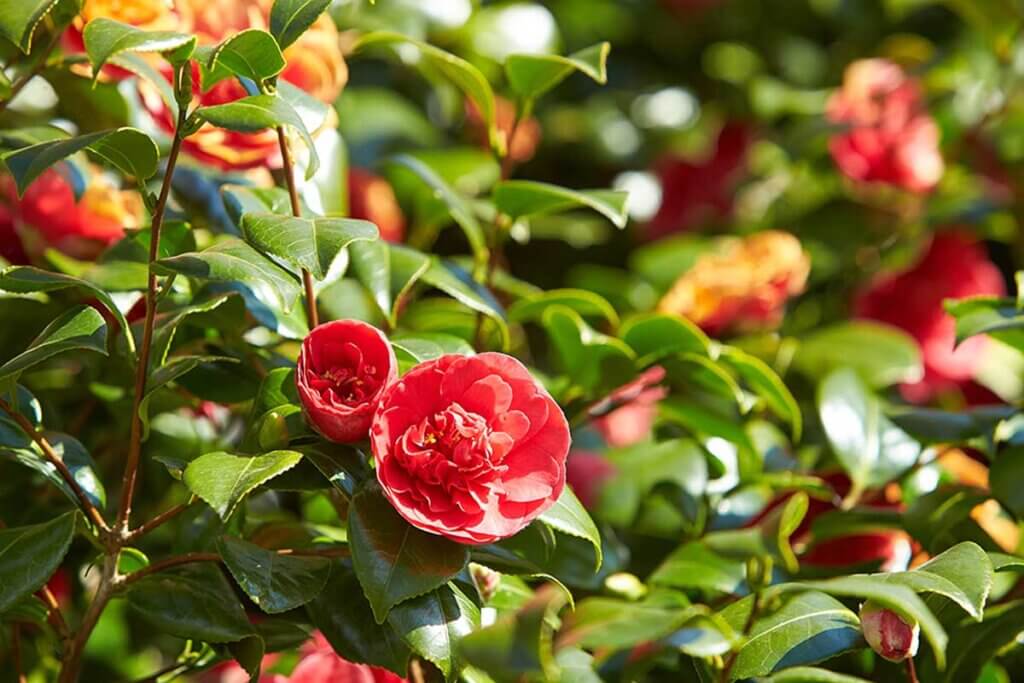Acidophilic Plants: What are They and How to Care for Them?

Plants have their own individual needs and their requirements depend on the species. There are so many different and unusual types with complex needs and an example of this is acidophilic plants.
As such, it’s worth getting to know this species so that you can provide it with all the care it needs so it grows in the best possible way.
If you’re interested in learning more about acidophilic plants, keep reading!
What are acidophilic plants?
Firstly, we need to point out that acidophilic plants need acidic soils to ensure optimal growth. The pH of this substrate must be between 5.5 and 6.5. There are many plant species that share this common characteristic including shrubs, bushes with or without flowers, creepers, and vines.

Hydrangeas: acidophilic plants
Hydrangeas are one of the most popular acid-loving plants. This is a medium-sized shrub species that grows very well in humid climates.
They bloom in a beautiful and striking way and the most popular colors are white and blue. In fact, its flowers will turn a stronger shade of blue, the higher the acidity of the soil.
Camellias
Camellias bloom in winter and bring a little color and warmth to the coldest season of the year. It’s a very resistant and bushy species that reaches its maximum point during the snow.
In addition to providing it with a large amount of substrate, you should also ensure that it has sufficient watering so that it reaches the optimum humidity level. During the summer, it’s advisable to keep it in the shade.
Japanese maple
This is a small tree that grows slowly and bears leaves that change color depending on the season of the year. Generally, its leaves go from green to deep red with beautiful golden transitions.
It thrives in acidic soils and when it’s protected from direct sunlight. This tree also requires abundant watering, especially during the summer.
Gardenias
Gardenias are beautiful flowers with a romantic connotation, very similar to roses. It’s one of the few acidophilic plants that can be grown both indoors and outdoors.
However, in addition to acidic soil, it requires a certain level of protection from temperature changes. Also, it dislikes direct sunlight.
Heather
Heather is a resistant shrub that requires basic care and is probably the least demanding of the common acidophilic plants.
It can be planted in the garden and you can enjoy its beautiful clusters of pink or purple flowers with a lovely fragrance. It blooms during summer and fall.
General care of acidophilic plants
As you now know, each species of acidophilic plant requires specific care. However, there are some generalities that are also good to know.

Acidic soils
The main care that we must give to these plants is to provide them with acidic soil. However, it’s not always easy to identify pH levels in soil, so it’s recommendable to buy an acidic substrate in a specialized store.
The pH of these substrates must be low, at levels between 5.5 and 6.5. The soil should also have a low concentration of lime. The best climate to grow these plants is usually a rainy area because rainwater is slightly acidic.
Beware of sudden temperature changes
Each acidophilus has its own requirements, but as a general rule, you should protect them from sudden changes in temperature. To do this, you’ll need to consider the climate where you live. If you live in a temperate and humid area, put them in a sunny place. Equally, if you live in a hot and dry climate, they’ll do better in medium shade.
Additionally, if they’re not suitable species for winter, you’ll need to protect them from frost. In countries with seasons, it’s a great idea to grow them in pots. This way, you can move them around your home and garden, depending on the season.
Watering and irrigation
Watering acidophilic plants and paying special attention to this process is an important factor to consider. They require water without lime, so you may need to use distilled water or collect rainwater for irrigation.
Also, there’s a trick you can use to remove limescale and that is to add a few drops of lemon or vinegar to the water. Finally, keep in mind that these plants enjoy humidity, so constant watering must be maintained. But you must avoid them becoming waterlogged.
Protect acidophilic plants from iron chlorosis
If you notice that your acidophilic plants are turning yellow, you must act immediately! This condition is known as iron chlorosis and it occurs because the pH of the soil rises.
As such, it prevents them from assimilating iron as it should. To fix this, buy chelate iron and add it to the substrate, according to the manufacturer’s recommendations.
Ready to take care of your acidophilic plants?
Acidophilic plants are special because they require a specific substrate that maintains the pH to allow them to grow well. Additionally, they need a caregiver to maintain humidity and provide them with constant watering. This may seem like a lot of hard work, but taking care of them will be worth it in the long term!
Plants have their own individual needs and their requirements depend on the species. There are so many different and unusual types with complex needs and an example of this is acidophilic plants.
As such, it’s worth getting to know this species so that you can provide it with all the care it needs so it grows in the best possible way.
If you’re interested in learning more about acidophilic plants, keep reading!
What are acidophilic plants?
Firstly, we need to point out that acidophilic plants need acidic soils to ensure optimal growth. The pH of this substrate must be between 5.5 and 6.5. There are many plant species that share this common characteristic including shrubs, bushes with or without flowers, creepers, and vines.

Hydrangeas: acidophilic plants
Hydrangeas are one of the most popular acid-loving plants. This is a medium-sized shrub species that grows very well in humid climates.
They bloom in a beautiful and striking way and the most popular colors are white and blue. In fact, its flowers will turn a stronger shade of blue, the higher the acidity of the soil.
Camellias
Camellias bloom in winter and bring a little color and warmth to the coldest season of the year. It’s a very resistant and bushy species that reaches its maximum point during the snow.
In addition to providing it with a large amount of substrate, you should also ensure that it has sufficient watering so that it reaches the optimum humidity level. During the summer, it’s advisable to keep it in the shade.
Japanese maple
This is a small tree that grows slowly and bears leaves that change color depending on the season of the year. Generally, its leaves go from green to deep red with beautiful golden transitions.
It thrives in acidic soils and when it’s protected from direct sunlight. This tree also requires abundant watering, especially during the summer.
Gardenias
Gardenias are beautiful flowers with a romantic connotation, very similar to roses. It’s one of the few acidophilic plants that can be grown both indoors and outdoors.
However, in addition to acidic soil, it requires a certain level of protection from temperature changes. Also, it dislikes direct sunlight.
Heather
Heather is a resistant shrub that requires basic care and is probably the least demanding of the common acidophilic plants.
It can be planted in the garden and you can enjoy its beautiful clusters of pink or purple flowers with a lovely fragrance. It blooms during summer and fall.
General care of acidophilic plants
As you now know, each species of acidophilic plant requires specific care. However, there are some generalities that are also good to know.

Acidic soils
The main care that we must give to these plants is to provide them with acidic soil. However, it’s not always easy to identify pH levels in soil, so it’s recommendable to buy an acidic substrate in a specialized store.
The pH of these substrates must be low, at levels between 5.5 and 6.5. The soil should also have a low concentration of lime. The best climate to grow these plants is usually a rainy area because rainwater is slightly acidic.
Beware of sudden temperature changes
Each acidophilus has its own requirements, but as a general rule, you should protect them from sudden changes in temperature. To do this, you’ll need to consider the climate where you live. If you live in a temperate and humid area, put them in a sunny place. Equally, if you live in a hot and dry climate, they’ll do better in medium shade.
Additionally, if they’re not suitable species for winter, you’ll need to protect them from frost. In countries with seasons, it’s a great idea to grow them in pots. This way, you can move them around your home and garden, depending on the season.
Watering and irrigation
Watering acidophilic plants and paying special attention to this process is an important factor to consider. They require water without lime, so you may need to use distilled water or collect rainwater for irrigation.
Also, there’s a trick you can use to remove limescale and that is to add a few drops of lemon or vinegar to the water. Finally, keep in mind that these plants enjoy humidity, so constant watering must be maintained. But you must avoid them becoming waterlogged.
Protect acidophilic plants from iron chlorosis
If you notice that your acidophilic plants are turning yellow, you must act immediately! This condition is known as iron chlorosis and it occurs because the pH of the soil rises.
As such, it prevents them from assimilating iron as it should. To fix this, buy chelate iron and add it to the substrate, according to the manufacturer’s recommendations.
Ready to take care of your acidophilic plants?
Acidophilic plants are special because they require a specific substrate that maintains the pH to allow them to grow well. Additionally, they need a caregiver to maintain humidity and provide them with constant watering. This may seem like a lot of hard work, but taking care of them will be worth it in the long term!







